Biology Notes: Pineal, Thyroid, and Parathyroid Glands
Chemical Coordination and Integration
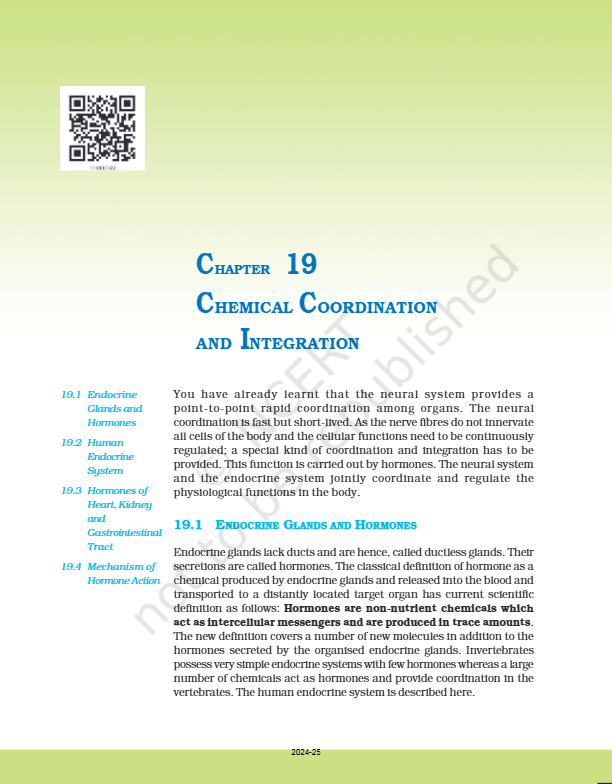
Overview
- The human body relies on both neural and endocrine systems for coordination.
- Neural coordination is fast but short-lived.
- The endocrine system uses hormones for sustained and widespread regulation.
Endocrine Glands and Hormones
Characteristics of Endocrine Glands
- Ductless Structures: Unlike other glands, endocrine glands do not have ducts.
- Hormone Secretion: They secrete hormones directly into the bloodstream.
Definition of Hormones
- Traditional Definition: Chemical messengers produced by endocrine glands, transported through the blood to distant organs.
- Current Scientific Definition: Hormones are non-nutrient chemicals that serve as intercellular messengers. They are produced in trace amounts.
Insights:
- Hormones play a critical role in maintaining homeostasis.
- The production of hormones in small amounts ensures precise regulation and minimizes potential side effects.
Comparison: Invertebrates vs. Vertebrates
- Invertebrates: Possess simpler endocrine systems with fewer hormones.
- Vertebrates: Exhibit more complex endocrine systems with a variety of hormones coordinating different bodily functions.
Importance of Chemical Coordination
- Vital for regulating physiological functions.
- Ensures that all cells and organs operate cohesively.
Human Endocrine System
- Describes how hormones operate in conjunction with the neural system to sustain various biological processes.
Additional Sections
- 19.1: Endocrine Glands and Hormones
- 19.2: Human Endocrine System
- 19.3: Hormones of Heart, Kidney, and Gastrointestinal Tract
- 19.4: Mechanism of Hormone Action
These sections elucidate the role and mechanisms by which hormones influence bodily functions, aiming to provide a detailed understanding of chemical coordination in humans.
Extended readings:
Human Endocrine System
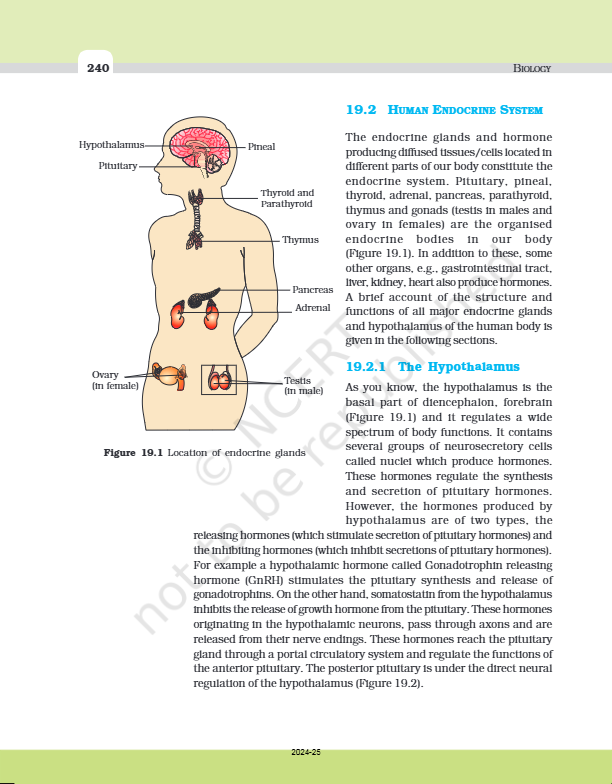
The endocrine system consists of glands and hormone-producing tissues that regulate various body functions by secreting hormones. This system includes several major glands, each with distinct roles.
Key Endocrine Glands
- Pituitary Gland: Often termed the "master gland," it regulates other endocrine glands.
- Pineal Gland: Produces melatonin, which regulates sleep cycles.
- Thyroid and Parathyroid Glands: Control metabolism and calcium levels, respectively.
- Adrenal Glands: Produce cortisol and adrenaline, managing stress responses.
- Pancreas: Regulates blood sugar levels through insulin and glucagon secretion.
- Thymus: Plays a role in immune system development.
- Gonads (Testes and Ovaries) : Produce sex hormones like testosterone, estrogen, and progesterone.
Insight: Each gland has a specialized function, but they maintain a complex network of interactions, ensuring homeostasis in the body.
The Hypothalamus
- Location: Situated in the basal part of the diencephalon, within the forebrain.
- Function: Regulates body functions by controlling hormone release from other glands, especially the pituitary gland.
- Types of Hormones:
- Releasing Hormones: Stimulate the secretion of pituitary hormones.
- Inhibiting Hormones: Prevent the release of specific pituitary hormones.
Examples of Hypothalamic Hormones
- Gonadotropin-Releasing Hormone (GnRH) : Stimulates pituitary synthesis and release of gonadotropins, affecting reproductive functions.
- Somatostatin: Inhibits growth hormone release from the pituitary.
Additional Information: These hormones are carried to the pituitary gland via a portal circulatory system, influencing anterior pituitary activities. The posterior pituitary functions under direct neural control from the hypothalamus.
Summary
The endocrine system, together with the hypothalamus, enables precise regulation of essential physiological processes. Understanding each gland's roles and their interconnections is crucial for recognizing how hormone imbalances can impact overall health.
Extended readings:
The Pituitary Gland
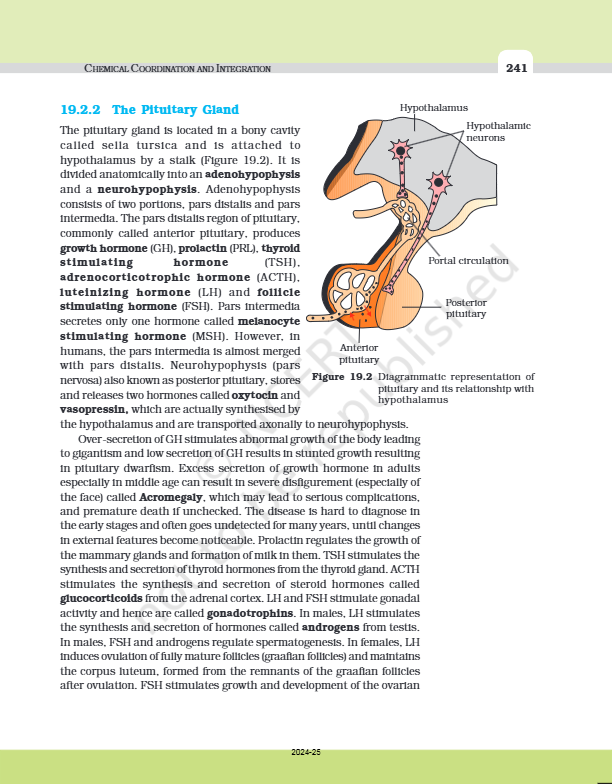
Overview
The pituitary gland is a critical endocrine gland located at the base of the brain, within a bony cavity called the sella turcica. It is connected to the hypothalamus by a stalk, playing a key role in hormonal regulation.
- Function
- The pituitary gland is often termed the “master gland” as it regulates a variety of bodily functions and other glands.
Structure
The pituitary gland divides anatomically into two main parts: adenohypophysis and neurohypophysis.
1. Adenohypophysis (Anterior Pituitary)
-
Pars Distalis
- Produces several key hormones:
- Growth Hormone (GH)
- Essential for body growth.
- Imbalance can lead to gigantism or dwarfism.
- Prolactin (PRL)
- Regulates milk production in mammary glands.
- Thyroid Stimulating Hormone (TSH)
- Stimulates thyroid hormone production.
- Adrenocorticotropic Hormone (ACTH)
- Promotes glucocorticoid production from the adrenal cortex.
- Luteinizing Hormone (LH) and Follicle Stimulating Hormone (FSH)
- Known as gonadotropins, they regulate reproductive processes.
- In males, they promote androgen production and spermatogenesis.
- In females, they induce ovulation and maintain the corpus luteum.
- Growth Hormone (GH)
- Produces several key hormones:
-
Pars Intermedia
- Secretes Melanocyte Stimulating Hormone (MSH)
- In humans, it merges with pars distalis.
2. Neurohypophysis (Posterior Pituitary)
- Stores and releases hormones synthesized by the hypothalamus:
- Oxytocin
- Enhances uterine contractions during childbirth and milk ejection.
- Vasopressin (Antidiuretic Hormone, ADH)
- Regulates water retention in kidneys and blood pressure.
- Oxytocin
Disorders Associated with Pituitary Gland
- Gigantism: Caused by GH overproduction in children.
- Dwarfism: Due to insufficient GH.
- Acromegaly: GH excess in adults leading to disfigurement.
- Hard to diagnose early; features become noticeable later.
Diagram
graph TD;A[Hypothalamus] -->|Stalk| B[Adenohypophysis] & C[Neurohypophysis]B --> D[GH]B --> E[PRL]B --> F[TSH]B --> G[ACTH]B --> H[LH & FSH]C --> I[Oxytocin]C --> J[Vasopressin]
Additional Notes
- Gonadotropins: These regulate sexual function, facilitating fertility in both male and female bodies.
- Glucocorticoids: Hormones pivotal for stress response and metabolism.
- Conditions such as acromegaly can lead to significant complications, emphasizing the importance of early detection and treatment.
This concise overview provides essential details about the pituitary gland's role, structure, and associated hormonal functions and disorders.
Extended readings:
Biology Notes on Glands
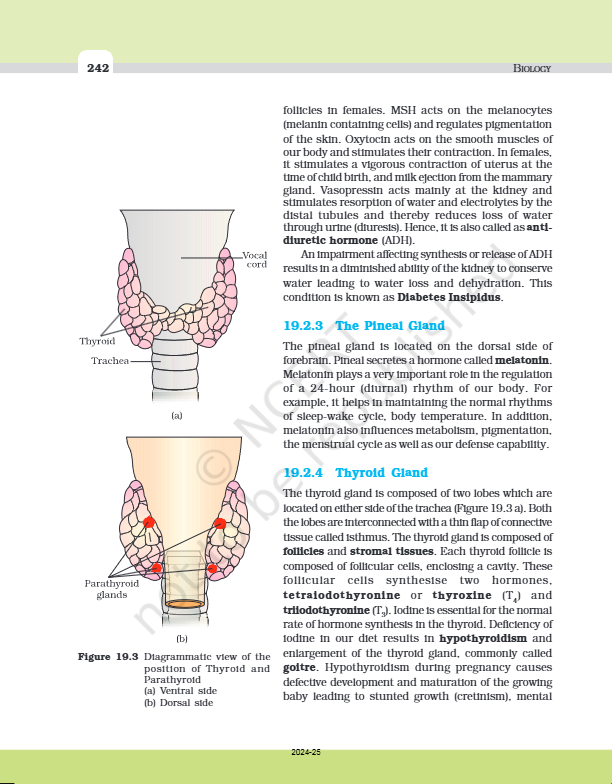
Pineal Gland
- Location: Dorsal side of the forebrain.
- Hormone: Melatonin.
- Role: Regulates the 24-hour diurnal rhythm of the body.
- Functions:
- Maintains sleep-wake cycles and body temperature.
- Influences metabolism, pigmentation, menstrual cycle, and defense capability.
Insights:
- Melatonin: Known for its role in circadian rhythms, melatonin is crucial for adaptive sleep patterns. It also acts as an antioxidant.
- Health Tip: Exposure to light can decrease melatonin production, influencing sleep quality.
Thyroid Gland
- Structure: Composed of two lobes on either side of the trachea connected by the isthmus.
- Components:
- Follicles: Enclose cavities formed by follicular cells.
- Stromal tissues.
- Hormones Produced:
- Tetraiodothyronine (Thyroxine, T₄)
- Triiodothyronine (T₃)
- Iodine Requirement:
- Essential for hormone synthesis.
- Deficiency leads to hypothyroidism and goitre.
Insights:
- Impact of Iodine Deficiency:
- Can lead to goitre due to the enlargement of the thyroid gland.
- Causes hypothyroidism, potentially leading to developmental issues like cretinism in infants if the mother is iodine-deficient during pregnancy.
- Thyroid's Role:
- Regulates metabolism.
- Crucial for growth and development, especially in children.
Additional Information:
- Goitre: Visible enlargement of the thyroid gland often due to iodine deficiency.
- Hypothyroidism: Condition of underactive thyroid, leading to fatigue, weight gain, and mood swings.
Conditions and Terms
- Diabetes Insipidus: A condition related to impaired synthesis or release of ADH (anti-diuretic hormone), leading to water loss and dehydration.
- ADH (Vasopressin): Hormone that helps the kidneys conserve water, reducing urine production and dehydration risk.
Additional Insights:
- ADH Function: Key to maintaining fluid balance in the body, crucial for hydration and electrolyte regulation.
Diagrams
- Includes diagrammatic representation of the thyroid and parathyroid glands showing their locations and structures on the ventral and dorsal sides.
This structured approach highlights the functions, location, and medical implications of the pineal and thyroid glands, as well as conditions like diabetes insipidus and goitre.
Extended readings:
Chemical Coordination and Integration
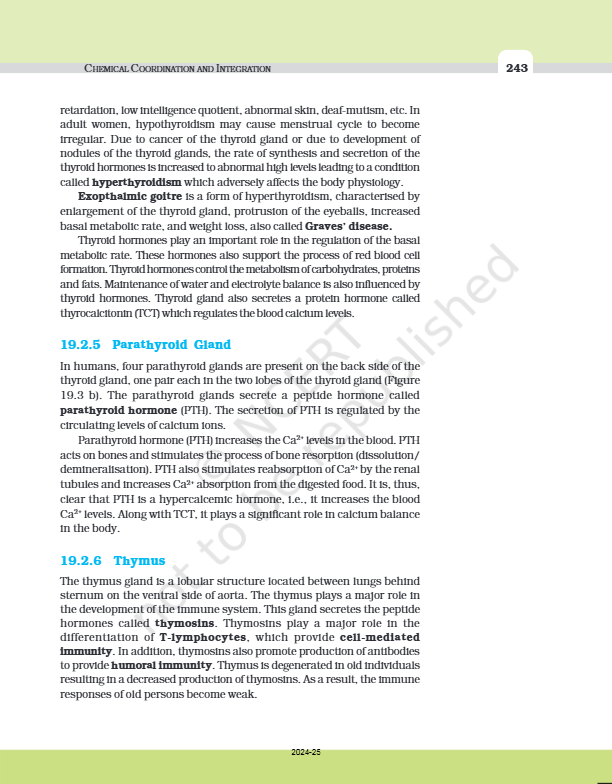
Thyroid Gland
-
Hyperthyroidism:
- Caused by increased synthesis and secretion of thyroid hormones.
- Symptoms include body physiology disruptions.
- Exophthalmic goitre/Graves’ disease:
- Characterized by thyroid gland enlargement, eyeball protrusion, higher basal metabolic rate, and weight loss.
-
Role of Thyroid Hormones:
- Regulate basal metabolic rate.
- Support red blood cell formation.
- Control carbohydrate, protein, and fat metabolism.
- Influence water and electrolyte balance.
-
Thyrocalcitonin (TCT) :
- Protein hormone regulating blood calcium levels.
Parathyroid Gland
-
Location and Structure:
- Four glands located on the thyroid gland's backside, one pair in each lobe.
-
Parathyroid Hormone (PTH) :
- Regulates calcium ion circulation and increases blood calcium levels.
- Stimulates bone resorption and enhances renal reabsorption and intestinal absorption of calcium.
- Hypercalcemic hormone: Increases blood Ca²⁺ levels.
Thymus
-
Location and Function:
- Lobular structure between the lungs, behind the sternum.
- Crucial in immune system development.
-
Hormones:
- Thymosins: Promote T-lymphocyte differentiation and cell-mediated immunity.
- Support humoral immunity by boosting antibody production.
-
Age-Related Changes:
- Thymus degenerates with age, reducing thymosin production and weakening immune response.
Extended readings: